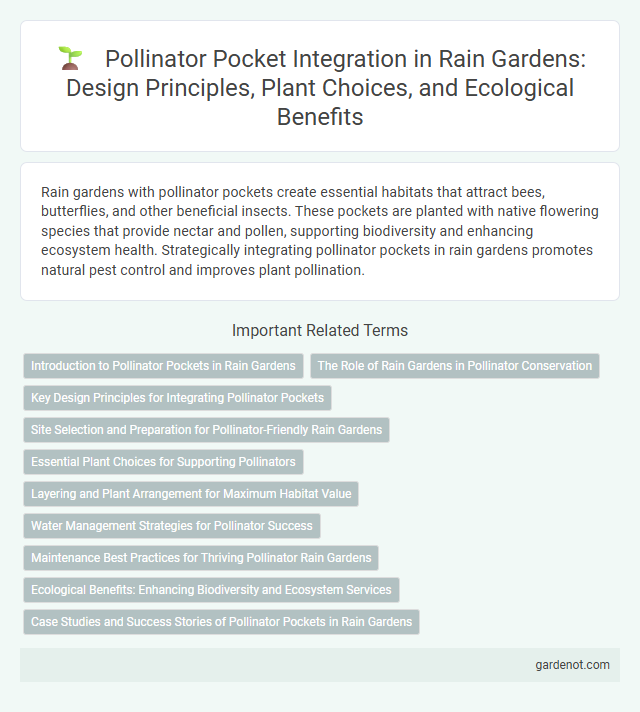Rain gardens with pollinator pockets create essential habitats that attract bees, butterflies, and other beneficial insects. These pockets are planted with native flowering species that provide nectar and pollen, supporting biodiversity and enhancing ecosystem health. Strategically integrating pollinator pockets in rain gardens promotes natural pest control and improves plant pollination.
Introduction to Pollinator Pockets in Rain Gardens
Pollinator pockets in rain gardens provide essential habitats that support bees, butterflies, and other pollinating insects critical for biodiversity and ecosystem health. These specialized planting areas feature native flowering plants that thrive in moist conditions, enhancing pollination efficiency and promoting local flora growth. Integrating pollinator pockets into rain gardens improves stormwater management while creating vibrant, sustainable environments for pollinator populations.
The Role of Rain Gardens in Pollinator Conservation
Rain gardens serve as vital Pollinator pockets by providing diverse native plants that supply nectar and pollen essential for bees, butterflies, and other pollinators. Their strategic design improves stormwater management while creating habitat corridors that support pollinator biodiversity in urban and suburban landscapes. Integrating rain gardens reduces habitat fragmentation and promotes ecological resilience, crucial for sustaining declining pollinator populations.
Key Design Principles for Integrating Pollinator Pockets
Pollinator pockets in rain gardens should prioritize native flowering plants that bloom in staggered seasons to support diverse pollinator species year-round. Incorporating varied plant heights and textures creates microhabitats, enhancing shelter and foraging opportunities for bees, butterflies, and hummingbirds. Ensuring proper soil drainage and avoiding pesticide use further optimizes conditions for sustainable pollinator populations within the rain garden ecosystem.
Site Selection and Preparation for Pollinator-Friendly Rain Gardens
Selecting a sunny location with well-drained soil is crucial for establishing a pollinator pocket within a rain garden, as most pollinator-friendly plants require ample sunlight and moderate moisture. Preparing the site involves removing invasive species, amending the soil with organic matter to enhance nutrient content and drainage, and creating shallow depressions to capture rainwater efficiently. Incorporating native flowering plants such as coneflowers, milkweed, and bee balm supports pollinator biodiversity and ensures the sustainability of the rain garden ecosystem.
Essential Plant Choices for Supporting Pollinators
Selecting native wildflowers such as Echinacea purpurea, Asclepias tuberosa, and Monarda didyma enriches pollinator pockets by providing abundant nectar and pollen essential for bees, butterflies, and hummingbirds. Incorporating a variety of bloom times ensures continuous food resources throughout the growing season, supporting diverse pollinator populations. Including host plants like milkweed and goldenrod promotes larval development, increasing the effectiveness of rain gardens as pollinator habitats.
Layering and Plant Arrangement for Maximum Habitat Value
Pollinator pocket design in rain gardens maximizes habitat value through strategic layering and plant arrangement, combining ground covers, flowering perennials, and shrubs to create diverse microhabitats. Native species like milkweed, coneflowers, and goldenrod provide essential nectar and pollen sources while structural variety supports different pollinator species including bees, butterflies, and hummingbirds. Proper spatial distribution enhances sunlight exposure and moisture retention, boosting overall biodiversity and pollinator health.
Water Management Strategies for Pollinator Success
Pollinator pockets in rain gardens enhance water management by capturing and filtering stormwater runoff, reducing soil erosion and nutrient loss. Strategically designed microhabitats retain moisture while preventing waterlogging, creating optimal conditions for pollinator plant species to thrive. Integrating native, drought-resistant plants improves water infiltration and supports diverse pollinator populations year-round.
Maintenance Best Practices for Thriving Pollinator Rain Gardens
Regular removal of invasive weeds and dead plant material is essential for maintaining a thriving pollinator pocket in rain gardens. Optimizing soil moisture through targeted watering during dry spells ensures healthy plant growth and supports diverse pollinator species. Periodic soil testing and organic mulching promote nutrient-rich conditions crucial for native flowering plants that attract bees, butterflies, and other pollinators.
Ecological Benefits: Enhancing Biodiversity and Ecosystem Services
Pollinator pockets within rain gardens create critical habitats that support diverse species of bees, butterflies, and other pollinators, thereby enhancing local biodiversity. These pockets improve ecosystem services such as pollination, which boosts plant reproduction and food production in urban and suburban areas. By increasing native plant diversity, pollinator pockets also strengthen resilience against environmental stressors and promote balanced ecological interactions.
Case Studies and Success Stories of Pollinator Pockets in Rain Gardens
Pollinator pockets in rain gardens have demonstrated significant ecological benefits by supporting diverse native pollinator species and enhancing urban biodiversity. Case studies from cities like Portland, Oregon, and Toronto, Canada, highlight how these specially designed microhabitats increase local pollination rates and improve stormwater management through native plant integration. Success stories reveal notable improvements in pollinator visitation and overall ecosystem resilience, validating pollinator pockets as effective components in sustainable urban landscape design.
Pollinator pocket Infographic

 gardenot.com
gardenot.com